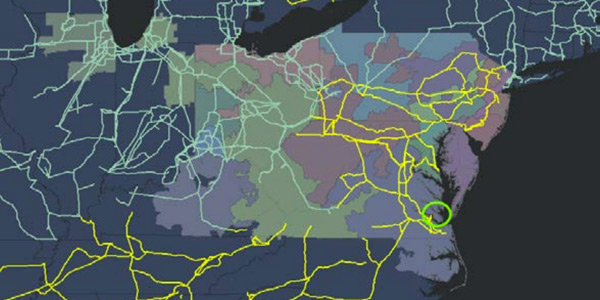By Rory D. Sweeney
PJM is responding to permitting delays for a 500-kV transmission line across the James River by instituting a multilayered strategy that could cost ratepayers in Virginia’s middle peninsula.
The Surry-Skiffes Creek line was proposed to maintain grid reliability on the peninsula after Dominion Energy complies on May 1 with an EPA mandate to shutter its two Yorktown coal-fired units. The project’s opponents are concerned the line would ruin the view at Jamestown and other historic sites nearby. A study conducted on behalf of the National Parks Conservation Association concluded Dominion overestimated projected power growth and called for consideration of other alternatives, including underwater lines and converting the Yorktown units to natural gas.
Approved by the PJM Board of Managers in 2012, the transmission project remains stalled pending permit approval from the U.S. Army Corps of Engineers. Dominion representatives have estimated construction of the line would take at least one year after all permits are approved.
Remedial Action Scheme
Opponents have dismissed as a scare tactic Dominion’s warning that failing to build the line could result in blackouts, but the company announced last month it has developed a remedial action scheme for the region that calls for dropping service to approximately 150,000 customers to prevent a potential voltage collapse from N-1-1 contingencies. (See Dominion Says Blackouts the Only Solution for Va. Peninsula.)
At a series of committee meetings last week, PJM staff detailed several other changes for the area that will have consequences protesters likely haven’t imagined.
Paul McGlynn, PJM general manager of system planning, announced at the Transmission Expansion Advisory Committee meeting that the RTO has offered Dominion a reliability-must-run contract on the units starting on April 1 and continuing until either the transmission line is constructed or another reliability solution materializes.
PJM calculated that 44% of the costs for retaining the units would be allocated to Dominion’s Virginia Electric Power and Power Co., with nearly 10% each to American Electric Power’s East zone and Commonwealth Edison.
At the Market Implementation Committee meeting the day before the TEAC meeting, PJM staff presented its new Yorktown pricing interface, which will set real-time LMPs if demand response or other load-management resources are deployed. It would be triggered on a sub-zonal basis when thermal or voltage conditions are encountered that create N-2 or N-1-1 contingencies.
At the meeting, PJM’s Independent Market Monitor Joe Bowring took issue with the plan because it allows DR to set regional prices “well above any level that generation can set it” — potentially as high as $1,800 MWh. Prices in the region are usually around $40/MWh. The interface would only be modeled in the day-ahead market if conditions are known prior to market close, and it won’t be modeled for financial transmission rights auctions.
“It’d be one thing if DR were nodal and were dispatched with the same offer caps,” Bowring said. “In a sense, the core issue is that DR can have a price and set price at $1,800 or more.”


